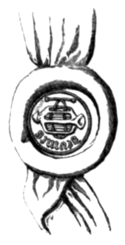Bastard of Falconbridge, sons respectively of Thomas Duke of Clarence, John Beaufort Earl of Somerset, Richard Neville Earl of Salisbury, and William Neville Lord Falconbridge. Should it be suggested that the i at the end of Bastardi in the deed exhibited is in reality a mark of contraction used after d to supply a final e, besides that it more resembles an i, all doubt on this point is removed by the original deed by which this Richard and his wife conveyed the advowson to Coburley and Burghille. On examining that, I found he is there called Ricardus Bastardus de Bedford' Armiger.[1] Now, had Bastard been a family surname in either case, it would hardly have been latinized; for such was not then the practice in preparing deeds; add to which, the name of no other person mentioned in the last-mentioned deed is followed by that of the place of his or her residence.
The seal of Richard remains attached, and a woodcut of it is given in the margin. It will be seen to be a small one with a device and motto, but no name; and consequently it affords no evidence as to who or what he was. Under all the circumstances, I think we may accept this Richard as a long-forgotten illegitimate son of John Duke of Bedford, uncle of Henry VI. and brother of the before-mentioned Duke of Clarence. I have sought in vain for any mention of such a son of his elsewhere. It is not at all improbable that an illegitimate son of that prince, even though recognized by him, should have passed into oblivion, if he did nothing to distinguish himself. There was an Earl of Bedford a few years earlier, who, in point of time, might possibly have been the father of this Richard, viz. Ingelram de Coucy, who came to this country as a hostage from France in 1303, and, having married Isabella, one of the daughters of Edward III. was created by him Earl of Bedford. On the renewal of the war with France in 1309, he went into
- ↑ The original deed, with the contracted words extended, except a few that are doubtful, is as follows: "Sciant presentes et futuri, quod nos Ricardus Bastardus de Bedford' Armiger et Isabella uxor mea dedimus, concessimus, et hac presenti carta nostra confirmavimus Thome Coburley et Thome Burghille omnia teraset tenementa nostra cum homagiis, feodis militum, maritagiis, releviis, escaetis, heriettis, redditibus, et serviciis omnium tenentium, tam liberorum quam nativorum, de feodo nostro vocato Wokendone Fee in villa de Terlyng Crikkeshithe, in comitatu Essex, una cum Advocacione Cantarie Sancti Thome in ecclesia cathedrali Sancti Pauli, London', ex parte boriali, cum omnibus suis pertinenciis; Habenda et tenenda omnia predicta terras et tenementa cum homagiis, feodis militum, maritagiis, releviis, escaetis, heriettis, redditibus, et serviciis omnium tenentium, tam liberorum quam nativorum, de feodo nostro predicto, una cum Advocacione Cantarie predicts, ut supradictum est, cum omnibus suis pertinenciis, prefatis Thome Coburley et Thome Burghille, heredibus et assignatis suis, de capitalibus dominis feodorum illonim per servicia

